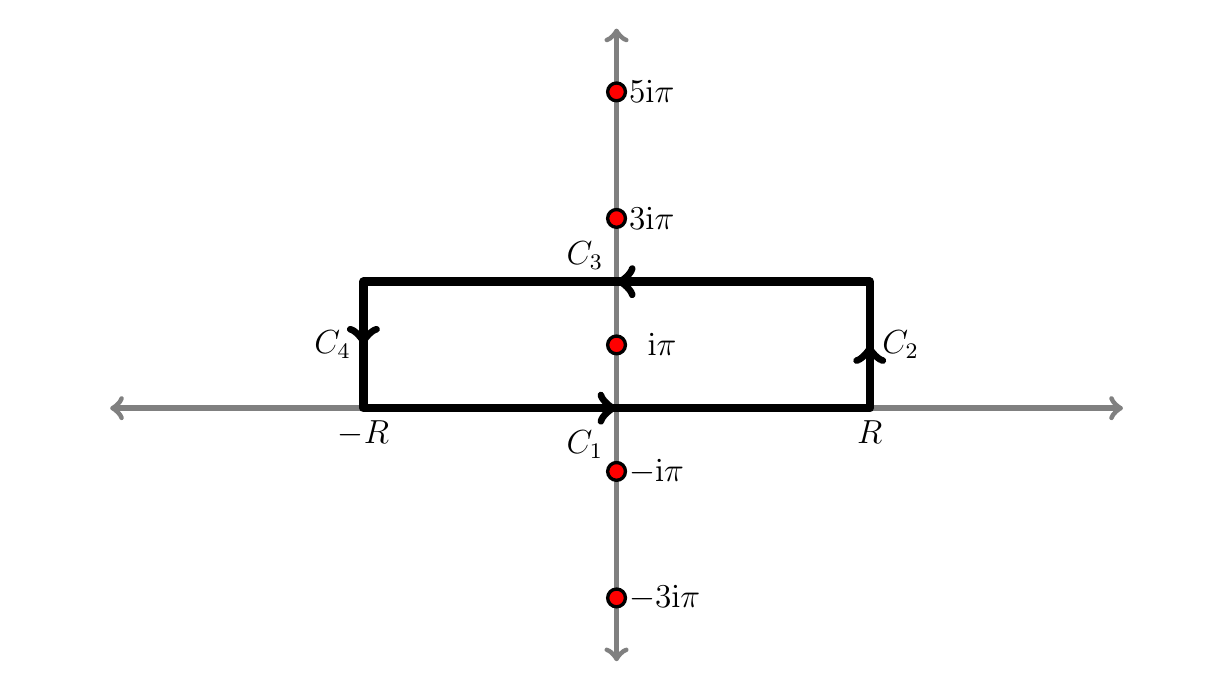I have not seen a one line proof of this statement. I believe there is no such a thing. The statement usually takes some work.
Here is my proof:
The formula states that
\begin{eqnarray}
\Gamma(1 -z ) \Gamma(z) = \frac{\pi}{\sin \pi z}
\end{eqnarray}
We show this formula using contour ingegration. We start with equation
for the Beta function in terms of the $\Gamma$ function (second property)
with $y=1-x$, and $0 < x < 1$. That is
\begin{eqnarray*}
\Gamma(x) \Gamma(1-x) =
\mathrm{B}(x, 1-x).
\end{eqnarray*}
We now show, by using contour integration, that
\begin{eqnarray*}
\mathrm{B}(x, 1-x) = \frac{\pi}{\sin \pi x}.
\end{eqnarray*}
For this, we use a Beta function representation ($\mathrm{B}=\int_0^{\infty} s^{x-1}/(1+s)^{x+y}$) which for
$y=1-x$ becomes
\begin{eqnarray*}
\mathrm{B}(x, 1-x) = \int_0^{\infty} \frac{s^{x-1} ds}{s+1}
\end{eqnarray*}
We use contour integration. Let us first make the substitution
$s=e^t$, $ ds = e^t dt$, and $t \in (-\infty, \infty)$. So we need to compute
We compute
\begin{eqnarray*}
\mathrm{B}(x, 1-x) = \int_{-\infty}^{\infty} \frac{\mathrm{e}^{t(x-1)}
\mathrm{e}^t dt}{\mathrm{e}^t+1} =
\mathrm{B}(x, 1-x) = \int_{-\infty}^{\infty}
\frac{\mathrm{e}^{tx} dt}{\mathrm{e}^t+1} \quad , \quad 0 < x < 1.
\end{eqnarray*}
Let us consider the contour integral
\begin{eqnarray}
I = \int_C f(z) dz,
\end{eqnarray}
with
\begin{eqnarray*}
f(z) = \frac{\mathrm{e}^{zx}}{\mathrm{e}^z+1} \quad , \quad 0 < x < 1.
\end{eqnarray*}
and $C$ is the contour that we need to determine. In the complex plane, the
poles of the integrand are the roots of $e^z+1$, that is
$\mathrm{e}^z = -1 = \mathrm{e}^{(2k+1) \mathrm{i} \pi}$ so the roots are
$z_k= (2k+1) \mathrm{i} \pi$, for $k=0, \pm 1, \pm 2, \cdots$.
Then $f(z)$ as an infinite number of poles all lying on the imaginary axis.
We will select a contour that has only one pole as shown in the Figure below
 The contour $C$ can be seen as the union of $C=C_1 \cup C_2 \cup C_3 \cup C_4$,
where $C_1$ and $C_3$ are horizontal lines from $-R$ to $R$ with opposite orientation.
We want to let $R$ grow to $\infty$. The paths $C_2$ and $C_4$ are vertical lines
between $0$ and $2 \pi \mathrm{i}$ with opposite orientations showed in the figure.
The contour $C$ can be seen as the union of $C=C_1 \cup C_2 \cup C_3 \cup C_4$,
where $C_1$ and $C_3$ are horizontal lines from $-R$ to $R$ with opposite orientation.
We want to let $R$ grow to $\infty$. The paths $C_2$ and $C_4$ are vertical lines
between $0$ and $2 \pi \mathrm{i}$ with opposite orientations showed in the figure.
From the
Residue Theorem we evaluate the integral over $C$. The residue corresponding to the
pole $z_0= \pi \mathrm{i}$, is computed using the expression
\begin{eqnarray*}
\lim_{z \to z_0} (z-z_0) f(z) = \lim_{z \to z_0} \frac{ (z-z_0) \mathrm{e}^{z x}}
{\mathrm{e}^z + 1} =
\lim_{z \to z_0} \frac{\mathrm{e}^{zx} + (z-z_0) \mathrm{e}^{zx}}{e^z} =
\mathrm{e}^{z_0 (x-1)}.
\end{eqnarray*}
where we use L'H^{o}pital's rule.
Hence $I = 2 \pi \mathrm{i} \; \mathrm{e}^{\pi i (x-1)}$
since the only residue inside the contour is at $z=\mathrm{i} \pi$ . That is,
\begin{eqnarray*}
2 \pi \; \mathrm{i} \; \mathrm{e}^{ \mathrm{i} \pi (x-1)}
=\int_{C_1} f(z) dz +
\int_{C_2} f(z) dz +
\int_{C_3} f(z) dz +
\int_{C_4} f(z) dz .
\end{eqnarray*}
We want to find $I_1=\int_{C_1} f(z) dz$, as $R \to \infty$. Let us first find the integral
along the vertical path $C_3$.
\begin{eqnarray*}
I_3 &=&
\int_R^{-R} \frac{\mathrm{e}^{ (t + 2 \pi \mathrm{i} ) x}}{\mathrm{e}^{t+2 \pi
\mathrm{i}} + 1 } d t \\
&=& \mathrm{e}^{2 \pi \mathrm{i} x}
\int_R^{-R} \frac{\mathrm{e}^{ t x}}{\mathrm{e}^{t+2 \pi
\mathrm{i}} + 1 } d t \\
&=& \mathrm{e}^{2 \pi \mathrm{i} x}
\int_R^{-R} \frac{\mathrm{e}^{ t x}}{\mathrm{e}^{t} + 1 } d t \\
&=& -\mathrm{e}^{2 \pi \mathrm{i} x} I_1,
\end{eqnarray*}
where we reversed the sign since $I_1$ is computed from $-R$ to $R$ instead of
going in the opposite direction.
The integral $I_2$ along the path $C_2$ is evaluated as follows
\begin{eqnarray*}
I_2 =
\int_0^{2 \pi} \frac{\mathrm{e}^{ (R + \mathrm{i} t ) x}}
{\mathrm{e}^{R+\mathrm{i} t} + 1 } d t
= \frac{\mathrm{e}^{R x} }{\mathrm{e}^R}
\int_0^{2 \pi} \frac{\mathrm{e}^{ (\mathrm{i} t ) x}}
{\mathrm{e}^{\mathrm{i} t} + 1/\mathrm{e}^{R} } d t
= \mathrm{e}^{R(x-1)}
\int_0^{2 \pi} \frac{\mathrm{e}^{ (\mathrm{i} t ) x}}
{\mathrm{e}^{\mathrm{i} t} + 1/\mathrm{e}^{R} } d t.
\end{eqnarray*}
Now, since $0 < x < 1$ (so $x-1 < 0)$, and the last integral is bounded we have that
$\lim_{R \to \infty} I_2 = 0$. The same argument applies for the integral $I_4$
along the path $C_4$. We then have that, from $I=I_1+I_2+I_3+I_4$,
\begin{eqnarray*}
2 \pi \mathrm{i} \mathrm{e}^{\mathrm{i} \pi (x-1)} =
(1 - \mathrm{e}^{2 \pi \mathrm{i} x}) I_1
\end{eqnarray*}
and
\begin{eqnarray*}
I_1 = \int_{0}^{\infty} \frac{s^{x-1} ds}{s+1} = \frac{ 2 \pi \mathrm{i}
\mathrm{e}^{ \mathrm{i} \pi (x-1)}}{1 - \mathrm{e}^{2 \pi \mathrm{i} x}}
= \frac{ \pi}{ \frac{\mathrm{e}^{\mathrm{i} \pi x} - \mathrm{e}^{-\mathrm{i} \pi x}}{2
\mathrm{i}}} = \frac{\pi}{\sin \pi x}.
\end{eqnarray*}
We then showed that Euler's reflection formula is correct.


